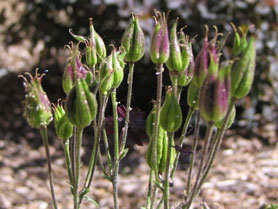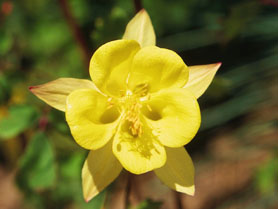Aquilegia spp.
Columbine
 |
Plant form |
Upright, herbaceous, deciduous, clumping perennial. |
Size |
6 to 48 inches tall, depending on species. |
Flowers |
In early summer, flower stalks rise delicately above the foliage. Flowers come in various shades and combinations of white, yellow, pink, red, blue, and purple. Most columbines have long nectary spurs on the flowers, but some types have very short spurs. Breeders have developed a few doubles that increase the showiness, but destroy the delicacy, of the flower. |
Leaves |
Lacy leaves are bluish green. |
Native area |
Northern Hemisphere, Washington state. |
Water use |
Moderate to low. |
Culture and maintenance |
Easy to grow in heavy or light soils, as long as they have good drainage. Leaves may begin to die back after flowering and look bad, so site the plant carefully. Columbines hybridize readily, so keep species separate if you want your seedlings to look like their individual parents. Most columbines will reseed. Cut off the seed heads to reduce the number of new plants or grow the plant where the new plants will be welcome, such as in a lightly shaded woodland. Cutting back the seed heads and aging foliage may also result in fresh leaves and some repeat flowering. Plants usually are not divided, but removed as they age and replaced by volunteer seedlings. Leaves are often attacked by a miner that feeds between the upper and lower layers of the leaf, leaving cleared tunnels within the leaf. The damage is primarily aesthetic. The leaves look bad, but the plant is usually not significantly affected by the feeding. This insect is difficult to eliminate. By the time you see the tunnels, the insect has already done the damage and may have even left the leaf. The easiest control is placing the plant where you won't be looking closely at the leaves. Some types of columbine are more likely to get miners than others. Aquilegia saximontana is an example of one that doesn't seem to get it. |
Light |
Full sun to partial shade. |
Hardiness |
USDA Zone 4. |
Other |
Aquilegia chrysantha (photo below, right) is a large light yellow columbine. The flowers have long spurs. It grows 3 to 4 feet tall. It is native in the southwestern US and Mexico. Aquilegia flavescens is smaller than A. chrysantha. Its pale yellow flowers have shorter spurs. It is native in the Pacific northwest, including Washington. Aquilegia formosa grows 2 to 3 feet tall. It is native in the Pacific northwest, including Washington. The flowers are red and yellow. |
  |
|
Life is good at WSU.
Secondary content can be almost anything. If you are not using this region delete all the content that is in between the div tags with the id ="additional".
A unique richness of students, faculty, location, activities, and organizations creates a full, lively student life at the University. This section gives you the insider's view on student life and a sampling of the opportunities here.
"Glimpses." Students talk about life at WSU
These brief posts are written by WSU students to give you a personal look through their window on campus life.